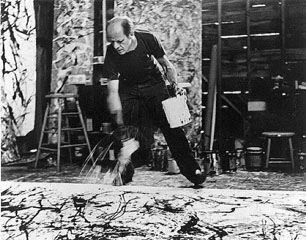Following the surrealist movement,
the first major avant- garde art movement emerged in America. The art movement
was known as Abstract Expressionism and developed in the 1940s but had its
roots in surrealism, and its earliest predecessor was Kandinsky. Unlike
surrealist painters who were greatly influenced by the philosophy of Sigmund
Freud, Abstract Expressionist followed the psychology of Carl Jung; abstract
expressionists focused their paintings around the “collective unconscious”, and
produced works that expressed the artist’s state of mind. The abstract expressionism
was comprised of two styles: gestural abstraction and chromatic abstraction.
Gestural abstractionist relied on movement and the energy by which the paint is
applied to canvas to express their unconscious. Chromatic abstraction focused
on a color’s emotional resonance and was made for the purpose of personal
reflection and meditation.
Jackson Pollock became, arguably,
the most famous gestural abstract expressionists in America. Pollock, aka “Jack
the Dripper”, developed a drip technique to his paintings. Rather than being
confined to a small canvas and easel, Pollock would produce large-scale
paintings by unrolling rolls of unsized canvas on the floor of his studio, used
brushes, sticks, towels, etc. in order to create rhythmic drippings, splatters,
and pools of paint on his canvas. His paintings trap the viewer in the web of
paint to open their subconscious emotions. Pollock’s paintings were both
spontaneous and choreographed. His murals emphasize the creative process and
his emotional state during his painting, he once stated “I feel nearer, more a
part of the painting, since this way I can walk around it, work from the four
sides, and literally be in the
painting.” (Gardner 34).

When I look at Pollock’s painting, Lavender Mist, I become overwhelmed at
first. I feel small in front of the aggressive strike, slashes, and pools of
paint; however, after several minutes of absorbing the painting, a since of
calm washes over me. Looking at a Jackson Pollock painting is like waking up in
the morning: at 7am the day seems overwhelming and impossible, but by noon you
remember how awesome life is and how happy you are that you get to spend
another day on this Earth.

No comments:
Post a Comment